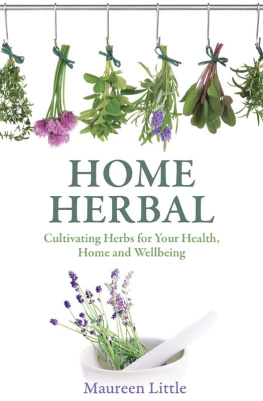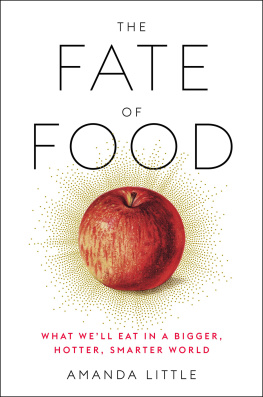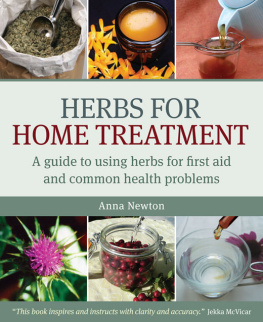Maureen Little is a gardener with professional experience in the commercial cultivation of plants. She is also a herb enthusiast and beekeeper. She has published extensively on herb and bee gardening and garden design. She is a member of the Herb Society and contributes to several national gardening and self-sufficiency magazines. Maureen has advised the RHS on herbs and gardening for bees, and offers courses in these areas to both the public and gardening societies. Maureens most recent books are The Bee Garden, Plants and Planting Plans for a Bee Garden, The Kitchen Herb Garden and The Little Book of Popular Perennials. She lives in Preston.

Also by Maureen Little
Plants and Planting Plans for a Bee Garden
The Bee Garden
The Kitchen Herb Garden
The Little Book of Popular Perennials
Country Skills and Crafts
Home Herbal

Maureen Little

Constable & Robinson Ltd
5556 Russell Square
London WC1B 4HP
www.constablerobinson.com
First published in the UK by How To Books,
an imprint of Constable & Robinson Ltd, 2014
Copyright Maureen Little 2014
The right of Maureen Little to be identified as the author of this work has been asserted by her in accordance with the Copyright, Designs & Patents Act 1988.
All rights reserved. This book is sold subject to the condition that it shall not, by way of trade or otherwise, be lent, re-sold, hired out or otherwise circulated in any form of binding or cover other than that in which it is published and without a similar condition including this condition being imposed on the subsequent purchaser.
A copy of the British Library Cataloguing in Publication
Data is available from the British Library
ISBN 978-1-84528-542-5 (paperback)
ISBN 978-1-84528-545-6 (ebook)
Printed and bound in the UK
1 3 5 7 9 10 8 6 4 2
Cover design by Nikki Parkes
For
Ruby and Luke
Acknowledgements
Once again I am indebted to my many wonderful relatives, friends and colleagues who provide unceasing encouragement and inspiration. Any mistakes are entirely my own.
Thanks especially to my family Georg, Becca and James, not forgetting Martin and Katie and the next generation of herb growers (I hope!), Ruby and Luke.
My thanks also go to Giles Lewis and Nikki Read without them this book, and the ones before it, would never have been written, and I am so grateful to them for their continued support.

Contents
Growing, Harvesting, Preserving and
Storing Your Herbs
Important Notice
T his book contains solely the views and opinions of the author. It is intended to provide interesting, helpful and informative material on the subjects addressed. It is sold with the understanding that it does not contain professional guidance and/or recommendations. The author and publisher disclaim all responsibility for any liability, loss or risk, personal or otherwise, incurred as a consequence, directly or indirectly, of the use and/or application of any of the contents of this book.
All reasonable care has been taken in the compilation of this book. The information it contains, however, is not a guide to self-diagnosis and treatment, and must not be substituted for medical care carried out under professional supervision by a qualified medical practitioner.
Pregnant or lactating women should also seek professional advice before taking or using any non-prescription treatments.
Readers are advised to consult a qualified medical practitioner for individual advice.
Introduction
How could such sweet and wholesome hours
Be reckoned but with herbs and flowers!
From The Garden by Andrew Marvell (162178)

I feel certain that anyone who has grown herbs will tell you that they soon started looking for ways to use them other than in cooking. A friend of mine has a magnificent herb garden, laid out in a traditional style, complete with lavender hedges and a centre-piece of a sun dial inscribed with Marvells couplet (above). She grows a huge range of herbs, from everyday parsley to highly poisonous Aconitum, and her knowledge of herbs is extensive. Apparently her love of herbs started and was subsequently nurtured when, as a child, she visited her Grandma once a week after school for tea. Each time she visited, Grandma had prepared something containing different herbs: savoury scones with rosemary; lemon curd tarts with verbena or a piece of hand-dyed material for her to make her doll a new dress. And when she tripped and grazed her knee, Grandma had a soothing salve to make it better.
My friend became curious about how Grandma grew all these herbs and so began her apprenticeship, as she now calls it. She discovered which herbs were good to eat, which can be used to make a dye, which can help you relax, and which have healing properties. Under Grandmas tutelage, she also learnt how to grow herbs, starting with a few chive seeds in a pot, later taking dozens of cuttings of lavender for Grandmas new hedge, which she has now replicated in her own garden.
Not everyone has the desire, or space, to follow in my friends size of footsteps, and many of us grow just a few herbs, such as rosemary or sage, to use in our cooking. But there are a number of common herbs that can be used in many different ways beyond the kitchen. For example, the two herbs I have just mentioned rosemary and sage have long been used in cosmetics and in herbal remedies. There are also many herbs that are not edible, but that can be used in the home in a variety of applications, as insect repellents or cleaners, fragrances or shampoos, or as a soothing salve or for sunburn relief.
What I would like to do in this book is to give you an insight into a number of herbs that can be used in non-culinary ways. It is by no means a comprehensive overview of all such herbs: rather it is a laypersons guide to how you can use a selection of common herbs in time-honoured but diverse ways; herbs that you may already have growing in your garden, or which are very easy to obtain.
Some of the recipes I include also call for ingredients which you are unlikely to be able to grow or produce yourself, like essential oils, for example. These are readily available from reputable suppliers, both on the high street and now also online.
What this book doesnt include is more specialised medical information this is the domain of experts and qualified practitioners. Any suggestions for using herbs in a therapeutic, remedial or curative manner are included because, through years of empirical use, they are considered safe to use in such ways.
In you will find some background information about how to grow your herbs, and how to harvest, preserve, and store them.
There are some herb garden designs in , from a basic first-aid collection to an anti-bug bed.
looks at herbs that can be used in remedies and as first-aid applications. There are a number of easy recipes, too, so that you can make your own preparations.
Next page




















